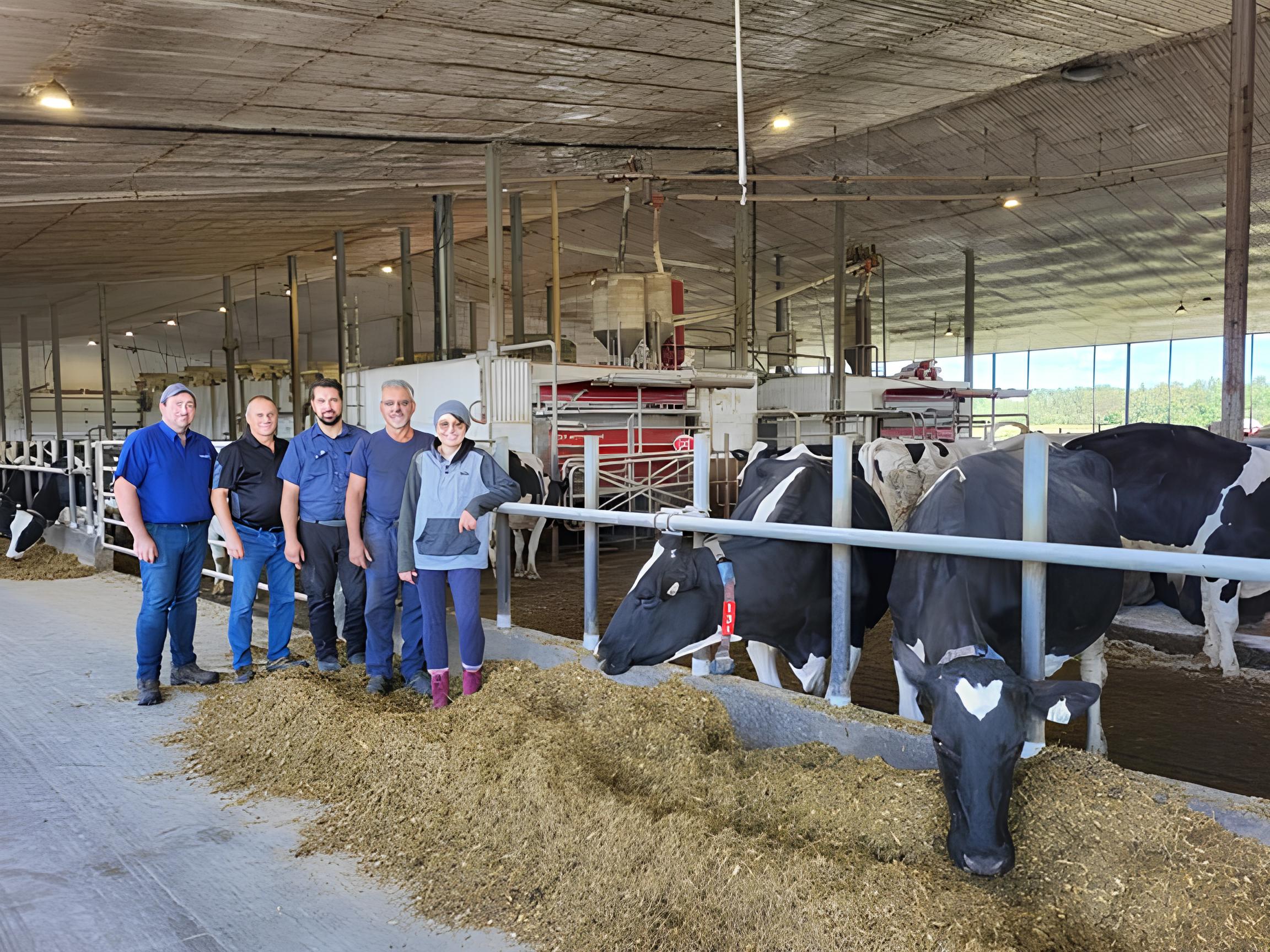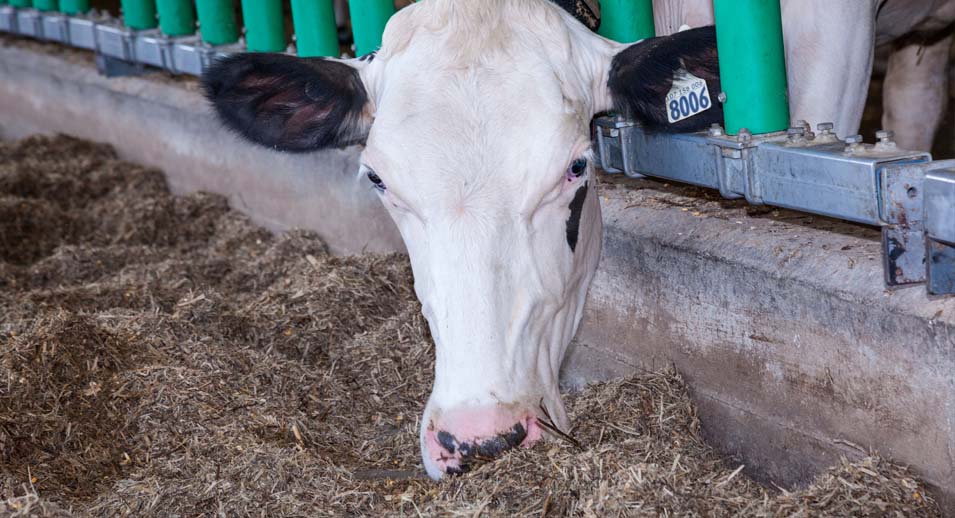Are peaks and persistency different for cows in robotic milking?
- January 26, 2021
Do cows in robotic milking systems get off to the same start in lactation and maintain the same persistency as those in other milking systems?
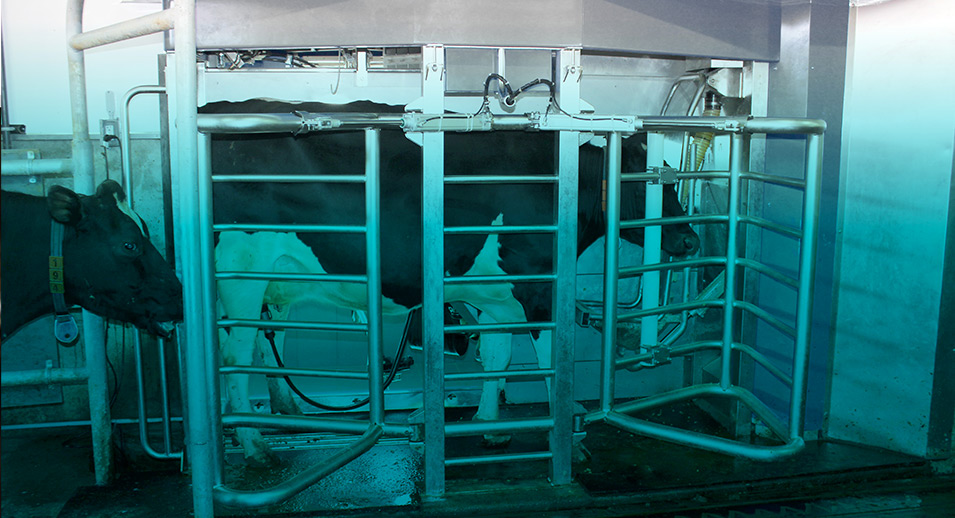
To answer that question, we consulted Lactanet’s database. The cows were divided into two groups, those in robotic milking systems and those in other milking systems with two milkings/day. Average daily milk yield per 10 days in milk was used for comparative purposes.
Number of milkings varies among robots
Robotic milking is the only system in which the number of milkings is variable. More frequent milking is encouraged at the start of lactation to stimulate the mammary gland and obtain higher peak yields. The number of milkings decreases gradually in mid- and late lactation. Does the variation in the number of milkings affect lactation curves? Separate graphs are shown below for primiparous and multiparous cows, with all production levels taken into account, for the year 2019.
A strong start
Primiparous cows
Initial production is slightly lower for first-lactation cows in robotic milking systems, but by 50 days in milk they surpass conventionally-milked cows and reach a higher peak yield. In both cases, production peaks at around 70 days in milk.
Graph 1. Average milk yield in relation to days in milk for primiparous cows in robotic milking systems versus their counterparts in other milking systems with two milkings per day.
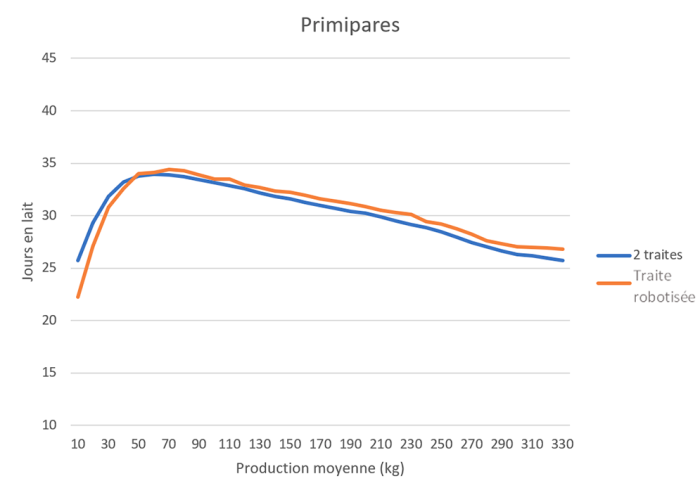
Table 1. Evolution of milk yield (kg/day) for primiparous and multiparous cows in robotic milking systems versus other systems with 2 milkings per day, for all levels of production.
| Primiparous cows | Multiparous cows | ||
Days in milk | Robot | Other systems (2 milkings) | Robot | Other systems (2 milkings) |
10 | 22.3 | 25.7 | 33.3 | 35.9 |
20 | 27.1 | 29.3 | 40.1 | 40.5 |
30 | 30.8 | 31.9 | 44.4 | 43.5 |
40 | 32.6 | 33.2 | 46.1 | 44.8 |
50 | 34.0 | 33.8 | 46.4 | 45.1 |
60 | 34.1 | 33.9 | 46.0 | 44.7 |
70 | 34.4 | 33.9 | 45.5 | 44.1 |
80 | 34.3 | 33.7 | 44.7 | 43.4 |
90 | 33.9 | 33.5 | 43.5 | 42.7 |
For primiparous cows, production from 10 days in milk to peak milk at 70 days in milk increases more rapidly in robotic milking systems. Average daily gains are as follows:
Robotic herds: 0.20 kg of milk/day in milk
Conventional herds: 0.14 kg of milk/day in milk
Multiparous cows
The lactation curve for multiparous cows is similar to that of first-lactation cows, with cows in robotic milking systems producing slightly lower yields than conventional herds at the start but surpassing them at 30 days in milk. In both cases, peak milk occurs at around 50 days in milk. But cows in robotic systems have consistently higher peaks.
Graph 2. Average milk yield in relation to days in milk for multiparous cows in robotic milking systems versus their counterparts in other milking systems with two milkings per day.
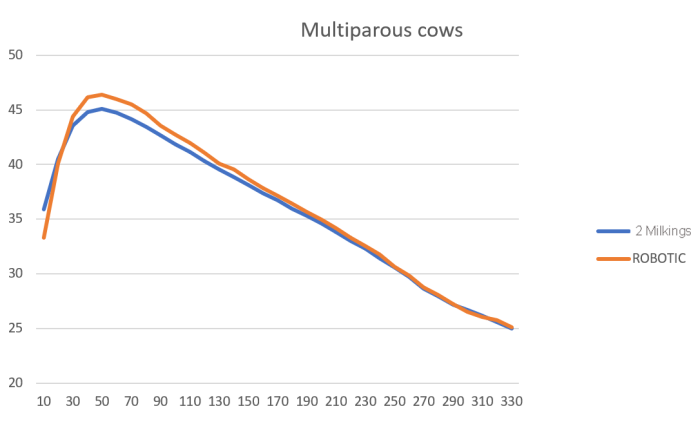
Production from 10 days in milk to peak milk at 50 days in milk increases more rapidly in robotic milking systems. Average daily gains are as follows:
Robotic herds: 0.33 kg of milk/day in milk
Conventional herds: 0.23 kg of milk/day in milk
Milk yields increase much more rapidly in robotic herds from the start of lactation to peak milk, 43% more rapidly in fact, and this applies as much to cows in their first lactation as to mature cows. This is undoubtedly part of the reason that research shows a risk of ketosis that is 1.45 times higher in robotic milking systems than in other types of milking systems.
Persistency, higher and lower
We looked at persistency in two different time periods: the period from 130 to 190 days in milk, and the period from 190 to 330 days in milk. Persistency was calculated on a 30-day rolling basis for each of these two periods. For the period from 190 to 330 days in milk, although the calculations were done for each 10-day stratum, the table includes only the results for 30-day strata to avoid overloading the table.
Primiparous cows
Table 2. Evolution of persistency for primiparous cows in robotic milking systems versus those in other systems with 2 milkings per day for the period from 130 to 190 days in milk.
| Primiparous cows | 30-day persistency for primiparous cows (%) | ||
Days in milk | Robot | Other systems (2 milkings) | Robot | Other systems (2 milkings) |
130 | 32.7 | 32.2 |
|
|
140 | 32.4 | 31.9 |
|
|
150 | 32.2 | 31.6 |
|
|
160 | 32.0 | 31.3 | 97.8 | 97.1 |
170 | 31.6 | 31.0 | 97.6 | 97.3 |
180 | 31.4 | 30.7 | 97.4 | 97.2 |
190 | 31.2 | 30.4 | 97.5 | 97.2 |
Average |
|
| 97.6 | 97.2 |
Primiparous cows in robotic milking systems show slightly higher lactation persistency than those in other milking systems. The same is true in later lactation (more DIM). For cows in robotic milking systems, average persistency is of course lower toward the end of lactation (96.8% – Table 3) than in mid-lactation (97.6% – Table 2).
Table 3. Evolution of persistency in primiparous cows in robotic milking versus those in other systems with 2 milkings per day for the period from 210 to 330 days in milk.
| Primiparous cows | 30-day persistency for primiparous cows (%) | ||
Days in milk | Robot | Other systems (2 milkings) | Robot | Other systems (2 milkings) |
210 | 30.5 | 29.9 | 97.2 | 97.4 |
240 | 29.4 | 28.9 | 96.5 | 96.6 |
270 | 28.2 | 27.4 | 95.8 | 95.0 |
300 | 27.0 | 26.3 | 95.8 | 95.9 |
330 | 26.8 | 25.7 | 99.1 | 97.8 |
Average |
|
| 96.8 | 96.5 |
Multiparous cows
There are no major differences in persistency between robotic herds and herds in other systems for the period from 130 to 190 days in milk, although the average was slightly lower in robotic herds (94.2% versus 94.4%).
| Multiparous | 30-day persistency for multiparous cows (%) | |||
| Days in milk | Robot | Other systems (2 milkings) | Robot | Other systems (2 milkings) |
| 130 | 40.1 | 39.6 | ||
| 140 | 39.6 | 38.9 | ||
| 150 | 38.7 | 38.2 | ||
| 160 | 37.9 | 37.4 | 94.5 | 94.5 |
| 170 | 37.2 | 36.7 | 93.9 | 94.6 |
| 180 | 36.4 | 36.0 | 94.2 | 94.2 |
| 190 | 35.7 | 35.3 | 94.2 | 94.4 |
| Average | 94.2 | 94.4 | ||
| Multiparous | 30-day persistency for multiparous cows (%) | |||
| Days in milk | Robot | Other systems (2 milkings) | Robot | Other systems (2 milkings) |
| 210 | 34.2 | 33.8 | 93.9 | 94.1 |
| 240 | 31.8 | 31.5 | 93.0 | 92.9 |
| 270 | 28.8 | 28.7 | 90.6 | 91.2 |
| 300 | 26.6 | 26.7 | 92.3 | 93.1 |
| 330 | 25.1 | 25.0 | 94.5 | 93.7 |
| Average | 92.8 | 93.0 | ||
Results seem to exceed expectations
The results differ somewhat from the generally-held perception of robotic herds. There are herds with much lower persistency at 200 DIM than the results shown here. Some robotic herds have a number of cows with a lactation persistency below 90% past 200 days in milk.
It is important to note that the number of milkings per cow decreases gradually over this period until dry-off. Some farms are more aggressive than others and demand a higher minimum milk yield per milking. The higher the target milk yield per milking, the more the number of milkings at the end of lactation is compromised, and persistency is likely to decline as well. This approach does keep more milk in the mammary gland, however, making it easier for the robot to attach the teat cups. In the case of a robot near maximum capacity, the decrease in the number of milkings at the end of lactation means that milking time can be redirected to cows in early lactation, which in turn allows fresh cows to milk more frequently and achieve higher peaks.




